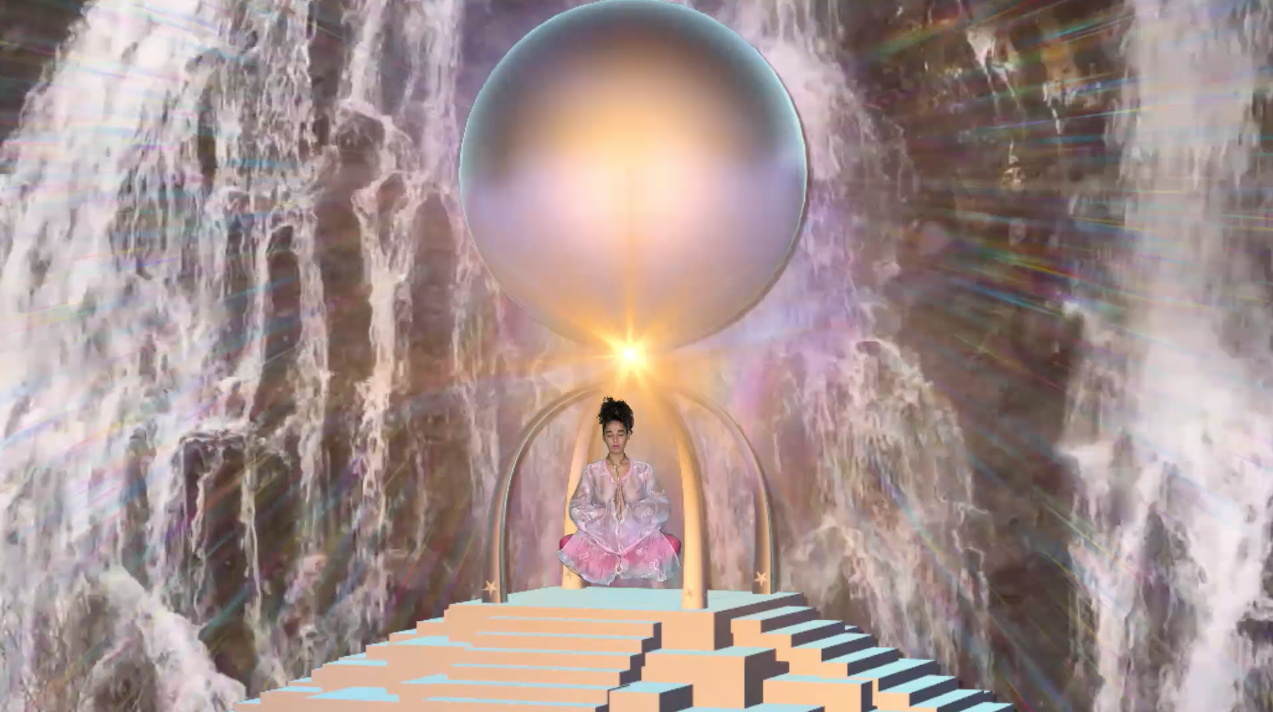The latest in a series of interviews with artists who have a significant body of work that makes use of or responds to network culture and digital technologies.
Eleanor Ford: You opened your first solo exhibition, Exotic Trade, at Goodman Gallery Johannesburg in May of 2017, and it seems, from afar, that it is a major expansion of your artistic and healing cosmology. This is my first exposure, through your work, to the idea of the “cosmos database”; an enormous idea that positions digital interfaces for ancestral and spiritual information. Can you talk about how you approach redefining and reimagining familiar terms and ideas (like downloading, optic cables, computing, etc) within the cosmos of decolonial technologies you present in your work? What kind of histories and spiritual practices do you draw from?
Tabita Rezaire: The cosmos is the ordered universe, as in, a whole and organized system, and it may contain many universes—previous, future, and parallel. Anyhow I believe the cosmos to be an immense storage of information. A mega hard drive of all that has been, is, and will ever be. All events, intentions, thoughts, feelings, sounds, words are stored in the cosmos’ database. It is a field of encoded energy we constantly upload to, some call it universal consciousness, Akashic records, Karma, collective unconscious, or astral light. It is basically a metaphysical archive on the scale of the universe that we can access and from which we can retrieve information. Direct downloads from the cosmos database were very common in some time-space, now it’s kind of niche as most of us are not tuned into the astral plane. Spiritual channeling, telepathy, visions and even intuition make use of that cosmic repository. Tapping into this is like connecting to the divine internet.
A lot of my work has focused on the internet as a colonized space and neocolonial technology, which had me yearning for other ways to connect. At the same time I found myself in spiritual communities in which I discovered spiritual technologies. My spiritual practice revealed decolonial technologies as a set of networked practices that were essentially ICTs—Information and Communication Technologies.
The definition of technology is the application of scientific knowledge for practical purpose. Here the tension lies within “scientific knowledge,” as the hierarchy between systems of knowledge inherited from the colonial era only considers Western rationalist/logic/“proven” knowledge as scientific. When you detach from these racist biases and allow other cultures of science to exist then the meaning of technology expands.
So ICTs are scientific knowledge applied for the purpose of information and communication. Outside of coloniality, then ancestor communication, as in receiving information from an ancestor, is a technology, a network for data transmission. Very much like the internet but instead of using optic fiber cables, it runs through energetic routes. Same goes for the use of teacher plants—like ubulawu or ayahuasca—which grant visions and messages when ingested, as well as yogic sciences, which allows you to open other information centers in your body so as to receive and share information as energy. These practices demand guidance, training or initiation as all traditions developed their own spiritual technologies, but there are so many interfaces available to connect and receive from the spiritual world: water, dreams, womb, and intuition...we just need to learn how to listen.
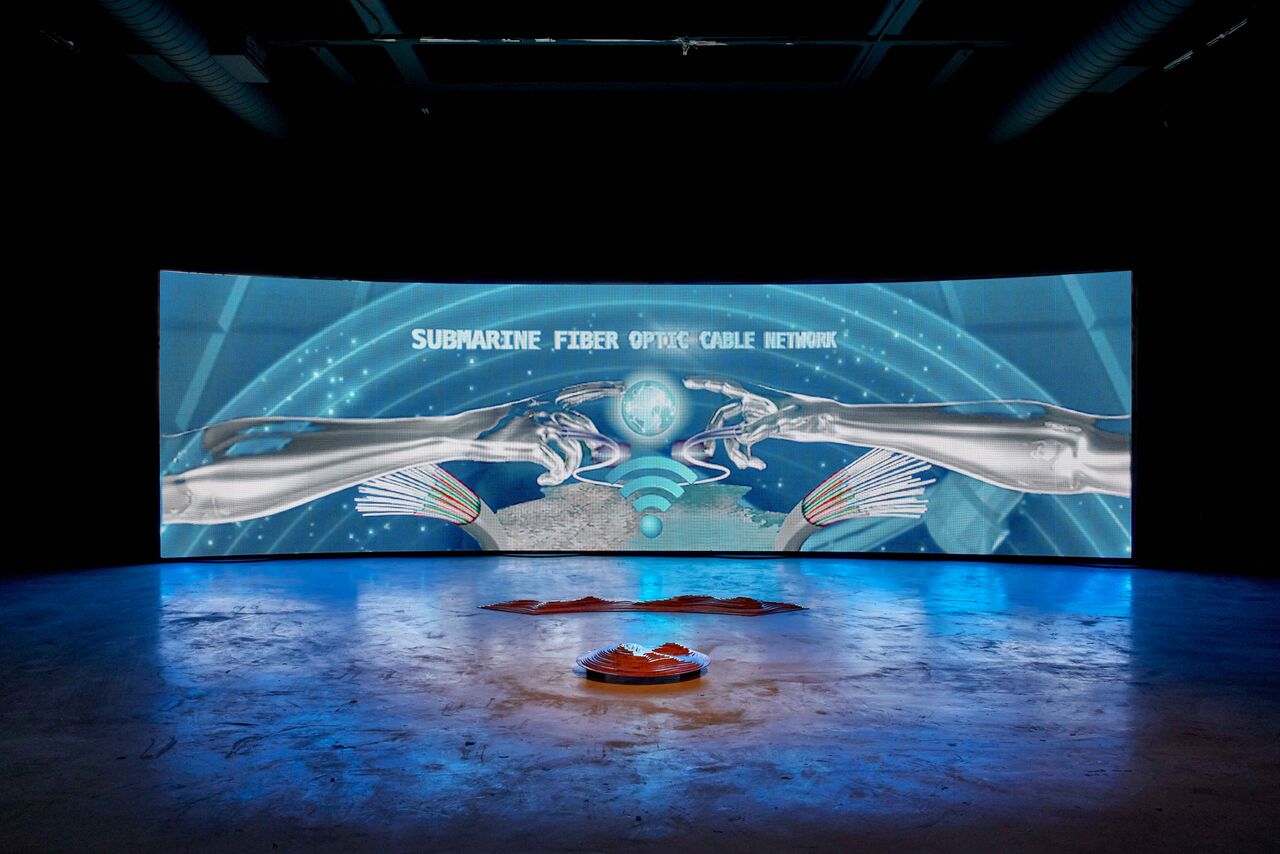 Tabita Rezaire, installation shot from Deep Down Tidal, 2017
Tabita Rezaire, installation shot from Deep Down Tidal, 2017
I draw from very diverse sources and transmissions. My research and influences span worldwide and extraterrestrial histories, mythologies, cosmologies, lineages, and sciences. The channeling is theoretical, intuitive, or experiential; it can be individual or collective and guided by a spiritual teacher/healer or ancestors. It involves the physical, emotional, mental, and spiritual bodies separately or together; some information translates into knowledge, others into wisdom. Here are some practices I resonated with in my life (but surely many lives before): dance, water, Judaism, daydreaming, drug culture, classical philosophy, psychoanalysis, European/eastern mysticism, oracles, Kemetic Yoga & Ancient Egyptian cosmology, Kundalini Yoga & Vedic sciences, Sufism, African and diasporic spiritual systems, South African traditional healing, Ifa, Amazonian teachings, herbalism, Tantra, Buddhism, conspiracy theory, alien/spirit channeling, New Age, animal life, astrology, numerology, physics, wombwork, dreams, sound, nature… They all inform each other and reflect my eclectic path, but the nature of my engagement with different teachings differs greatly, some I only read about, others I practice daily.
The traditions that lead my soul-heart now are my yogic practices of Kemetic and Kundalini Yoga and ancestor work through a Sangoma (South African traditional healer). Both are essential to my understandings of energy and spirit. My Kundalini teacher and Sangoma are my spiritual mothers; their teachings have been transformational forces of alignment in my life. I’m so grateful to you. Thank you.
Our soul bodies contain the whole universe, the whole of space-time. We are literally made of space-time. When we truly access ourselves, we access that cosmos database.
Tabita Rezaire, Premium Connect, 2017
EF: You’ve made numerous works that explore and celebrate Black femme technologies—Matrix and Sugar Walls Teardom both honor the forgotten histories of Black womxn whose lives and wombs contributed to gynecology and the bio-medical economy, while SENEB’s collaborative offering Hoetep Blessings (including your video of the same name, as well as works by Elizabeth Mputu and Fannie Sosa) preaches empowerment of Black femmeness to liberatory and healing ends. Your solo show was also oriented in the shape of a womb, which is such a beautiful detail.
In the contemporary era in which digital/technological colonialism converges with the continuing legacy of colonial history, how do you see the digital and spiritual spaces coming together in the process of healing, honoring and empowering the technologies of the cunt, the womb, and the natural energies of all Black femmeness? Does one serve the other?
TR: I believe spiritual spaces can be found anywhere and in anything, all spaces (thoughts and actions) are spiritual in potential, as spirit can be infused into everything. Only our intention and attention can turn a space-time into a work of spirit. You can be dancing in a ceremony or in the club, if you are consciously moving energy through your body-temple as a praise of the divine; you are in an act of spiritual communion. Same goes for cooking, walking, talking… it doesn’t matter what and where you do but how you do it.
I understand spirituality as the path that brings us to our soul and from there to source. There are an infinite numbers of paths, more than there are people. So I don’t see an inherent opposition between the digital and the spiritual. If your use of the digital assists you in meeting your soul, to become and realize the spirit that you are, then the digital can be a powerful spiritual tool. Any interface is fertile for spirit cause spirit is everywhere, just waiting to be revealed to itself.
The path of the womb has been and still is fundamental in my political and spiritual growth. The womb is a safe guarding treasures; it is our site of creation and with it comes immense power and responsibility. People with wombs hold the blueprint of creation, as they have the potential to birth life. They are in direct conversation with the cosmic womb that birthed our multiverse. Like an umbilical cord tying us back to source. Yet wherever you fall on the gender spectrum this area is your potent creative center, an energetic womb that can birth, if not a human life but spiritual manifestation like ideas, dreams, visions...its knowing and ways are so abundant.
This access point has been shattered by thousands of year of patriarchy and religious interpretations that shame the feminine, condemn sexual pleasure, and disgrace menstruations and birth. Everything relating to the womb and cunt has been vilified, and we unfortunately have all internalized this. Our wombs are traumatized and that blocks the flow of creation. Broken wombs birth broken beings/dreams. The collective state of our sites of creation reflects the collective state of the world. I’m certain that to serve our world we need to serve our wombs.
Creating a relationship with my womb, to its rhythms and flows taught me so much. It is a gateway to the divine within yourself, the teachings of the womb are lessons of spiritual embodiment. This connection allowed me to access repressed wounding—both my own and ancestral ones I was carrying—and attend to them.
This is what the works you mentioned are about, searching through womb lineages of hurt to start a healing process. Online, in VR, in our minds, 3D world, and other dimensions but always guided by the spiritual.
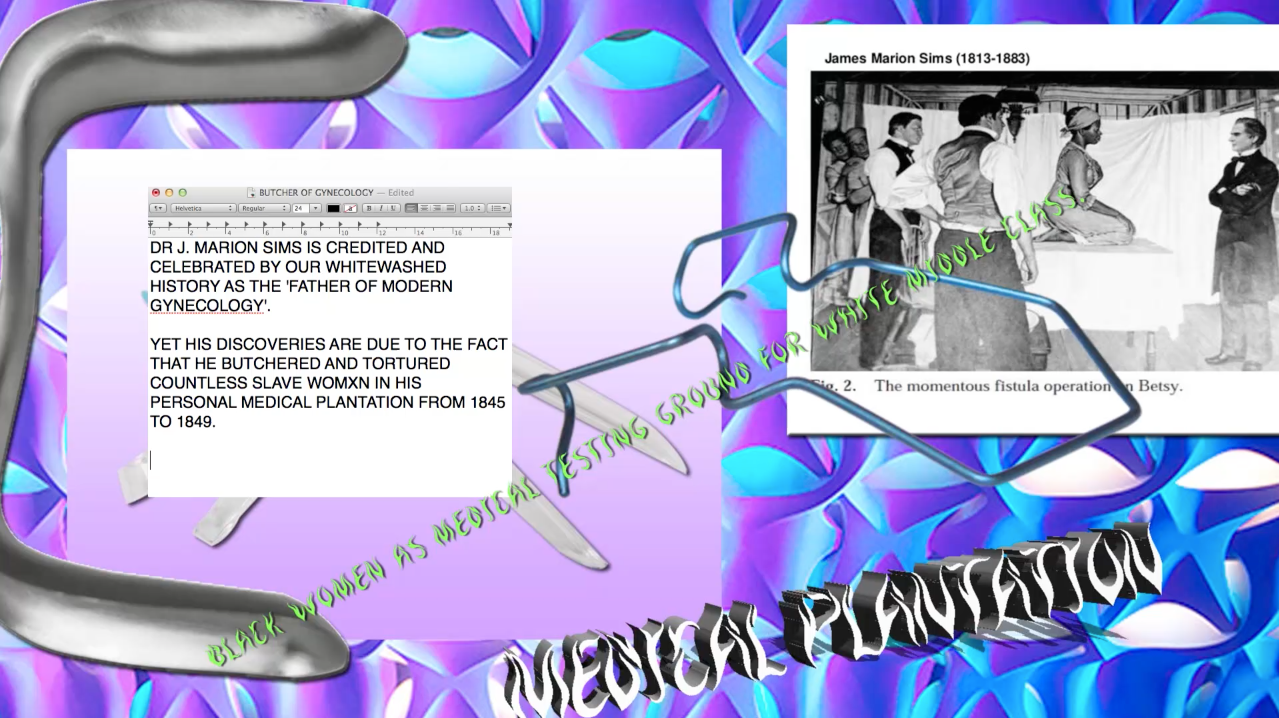
Tabita Rezaire, still from Sugar Walls Teardom, 2016
EF: While The House of SENEB emerged in 2016 as the central channel of your digital healing practice, you were already exploring the concepts of “decolonial self-care” and spiritual healing in your video Peaceful Warrior (2015)—a tutorial-esque guide for transitioning from being an “angry warrior” to being a “peaceful warrior.” The soundscape of Peaceful Warrior acts like a narrator of the spiritual transformation happening on screen—developing from meditative strides into discordant howls as you transform yourself through kemetic yoga, decolonial diet, and yonic twerking. The House of SENEB embraces sound and vibration as a major healing force. As you’ve spoken about previously, “SENEB comes from the ancient Kemetic word/symbol meaning health, but it also means sound or rather ‘to be sound’ or ‘to have soundness.’ The power of sound to heal is deep.” What is your relationship to sound as an artist who works with video, a spiritual practitioner? Do you make the music in your work?
TR: We are sound. We are sonic being. The world is sound. It’s also a very powerful technology. My relation to it keeps expanding and deepening as I explore diverse access points to it, from music, physics, spirituality, or mathematics all give different insights into the mysteries of sound. I’m so blessed to count as soul-friends very gifted musicians, so all music in my videos are the healing frequencies of beloved ones, Hlasko, FAKA, and CHI. I’m so grateful that their sounds bless my works. I’m in the process of slowly getting in that world but I’m still working on clearing my throat chakra. The voice is a healing instrument but it sometimes needs healing itself. I’m excited about what sounds and rhythms will come out through me.
In physics, sound is vibration that alters the pressure of air (or other medium sound goes through) propagating energy. Basically sound is vehicle for energy. We can use sound waves to carry the energy of our intentions. That is base of sound healing.
That’s why sound is so powerful. All spiritual traditions use sound in some form or another, chanting, praying, singing, mantra repetition, playing instruments to honor and communicate with the divine. These are methods of tuning ourselves to the whole, to the rhythm of the cosmos. The universe has a sound current, the primeval sounds of creation, which are still resonating.
Everything has its own vibrational frequency, also feelings and thoughts. Each frequency has a specific effect that can establish or disturb harmonic balance in a system. Sound shapes your state of consciousness. “Modern” science has now caught up and is calling this brain entrainment, where brain waves are able to synchronize to external sound wave. That’s why sound can be so healing if precise frequencies are used but also deadly. Sonic warfare is being used by many governments as a weapon.
The science of cymatic also shows a relationship between sound and the formation of geometric shapes in matter, with specific frequencies corresponding to specific forms. So sacred geometry in nature is the results of vibrational frequencies. Ancient Egyptians referred to geometry as “frozen music.”
I love the idea that sound shapes our world, that manifested creation is a result of the sound of creation itself. Actually many cosmological beginnings attributes the birth of the world to sound or a word. The words we use are actually so important; when we speak we spread (outward and inward) the frequency of that word on matter around us as energy propagate. The power of the word is so real.
The applications of sound healing are infinite. I play the gong and it has transformed my life. It feeds my soul. I trained this year in gong therapy and the science is so profound. The healing of the gong is powerful. It’s a soul alignment technology.
EF: I first saw your video essay Afro Cyber Resistance (2014) as a part of a class taught by manuel arturo abreu. In it you outline the colonialist patterns of information flow that recreate a Western hegemony online, and how South African internet artists are resisting the structures of a digital north/south divide. These ideas also hold space in your most recent work Deep Down Tidal through the language of “electronic colonialism,” which links the informatic and material forms of the internet to histories of Black death. Without asking you to reiterate the subjects of Afro Cyber Resistance (which everyone should go watch), as a Black femme artist and spiritual healer, how does your engagement with digital materialities and information economies shift in response to these colonialist realities?
Tabita Rezaire, Deep Down Tidal, 2017
TR: Already back in 1995 Ziauddin Sardar wrote: “The west urgently needs new spaces to conquer...and where they don’t actually exist, they must be created. Enter, cyberspace.” Electronic colonialism is that shift of former colonized countries into electronic colonies, of colonial subjects into global Westernized subjects and cyber slave. Electronic colonialism is so insidious, and because we are gladly hooked to our devices it’s even more dangerous. Even when we know how awful it is we still love it. It has been designed this way to build this attachment closer to addiction than love. How to put criticism into practice? How to take responsibility and implement a response? I’m still figuring it out, I guess the work I do is some kind of response.
While researching for the video Deep Down Tidal about transoceanic communication networks, I found out that our fiber optic cables are laid out onto former colonial shipping routes as most still follow the path of 19th-century copper telegraph cables. The internet is literally built on racist social engineering. I was petrified by this symbolism, yet this work brought a deep sense of calm, as water spirits also inhabit our deep seas. I was studying fractal at that time and suddenly my outlook shifted as I thought of fractal resilience. A fractal can be defined as infinity in a finite space, for some fractal arrangements it can also be multiple infinities in one finite space. If you transpose that mathematical definition to political struggles of emancipation, you have the finite space of our oppressive racist-rapey-colonialist-capitalist-industrial-legal complex, yet within it lies the potential for infinity. Infinity of experiences, of worlds, of ways of being and living no matter how small, or suffocating the finite structure is.
EF: The act of “disseminating light through screen based interfaces and energy streams” holds a central place in your praxis of digital healing activism. What is the importance of light to you, as a new media artist, a tech-politics researcher and a practitioner of spiritual/digital healing?
TR: Disseminating light is a call/practice/service of love, defiance and trust. To embody love as opposed to seeking something/someone to hold the loving. In defiance of all that which keeps spreading the hurts. In trust of better days and ways—where trust is no longer hope.
That deep knowing is light.
Light is energy. Light is a path. Yet it means very different things in different traditions of physics, religions, metaphysics, and mysticisms. In all those fields the meanings and disputes over meanings attributed to light are fascinating to me. I recently set up a brief school about “time” in Austria and we studied quantum physics, and went into past life regression, it revealed some of light’s complexities to me.
Why light is so central is that it defines one’s comprehension of the world (both in the world of physics and spirituality). Our 3D world is what it is for us humans because of how we interpret the light (electromagnetic radiations-EMR) that is reflected back from our surroundings. The thing is that out of the whole electromagnetic spectrum, we are only able to “see” a tiny fraction. That’s why we see/experience the world differently from other species as they might be sensitive to different EMR, infrared or ultraviolet for example.
The fascinating thing for me is the relational position of light and darkness. What we call darkness is only the absence of visible light for human. As we only see a limited part of the light spectrum, what we experience as darkness might be reflecting bright light/EM at a frequency we can’t perceive.
Darkness can be full of light.
That in the world of spirit means everything for me. The relationship between darkness and light in Western culture is very much one of opposition, light being associated with positive elements: life, goodness, heaven, while darkness carries negative attributes: death, danger, evil. This narrative is also carried as a common trope within racial hierarchies. Darkness also comes to mean the unknown and as the West is so uncomfortable with not knowing, that it vilifies everything outside of its premises of understanding. There is no space for coexisting worlds.
The unknown is the path of the mystic.
I believe healing starts with being in conversation with darkness, as in what is not exposed, outside of our knowing. Facing our fears, going where it hurts, revealing the wounds. Then slowly scarring, not physically but mentally, emotionally and spiritually. Learning to be comfortable with being uncomfortable. Healing is birthing a different state of being and birthing is always painful. This is also true of spiritual growth.
Some spiritual traditions speak of this transformation as a transition from darkness to light. I do associate spiritual light with a certain consciousness, with the illumination of our inner spirit. We are light beings and when we decide to walk the path of our soul, our light shines, but darkness is within light. Like my soul-friend Bogosi likes to say, we are light workers. In Kemetic cosmology, and many others, light was born out of the primeval darkness, the creative force of the universe being darkness. In astrophysics, stars turn into black holes and according to the big bounce theory, the cosmos is potentially a cyclical pattern of alternating big bang and big crunch (mega black holes that suck up the whole contracting universe). So universes are just being born, dissolved, and reborn.
I deeply resonate with a complementary approach, where light and darkness are two expressions of one entity. Like beloved in an embrace birthing one another like day and night, sunrise after sunset, big crunch after big bang, without one being more noble than the other, both as important, necessary and powerful in their own ways.
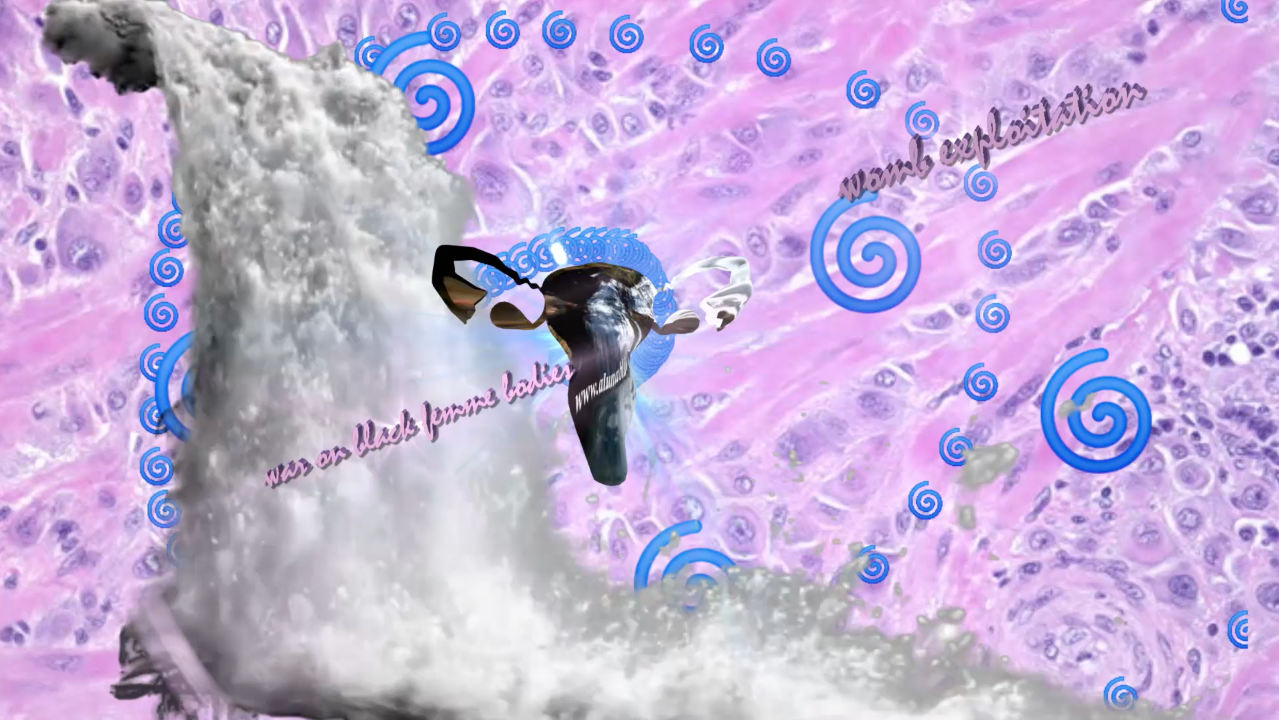
Tabita Rezaire, still from Sugar Walls Teardom, 2016
Questionnaire
How/when did you begin working creatively with technology?
I joined a photo club in 2009, and started to take analogue photos and developing them in the club’s darkroom. I left for London as an aspiring fashion designer and unexpectedly went into art. During all my studies I was very into analogue technology, only shooting in film with super 8 cameras. I was attached to the film as material and the process of developing. I remember a friend once told me: “The role of the artist is to comment on their time,” that struck me and I realized my use of film was a nostalgic fetish. I was writing my thesis on the politics of ecstasy and cruelty in film performance, only once I finished my MA, I really started a practice. I went in with the digital and got caught in the politics of digital technologies.
Where did you go to school? What did you study?
I studied economics for my BA, at University Dauphine in Paris, and did my last year at Copenhagen Business School in Denmark. Then I did an art foundation year at Central saint Martins in London and followed there with a research Master in Artist Moving Image.
What do you do for a living or what occupations have you held previously?
I currently work full time as an artist.
Since my teens I’ve worked as vegetable merchant on markets, retail assistant, math and physics tutor, babysitter, call center agent, French tutor, hostess, dissertations editor, club door girl, waitress.
What does your desktop or workspace look like? (Pics or screenshots please!)
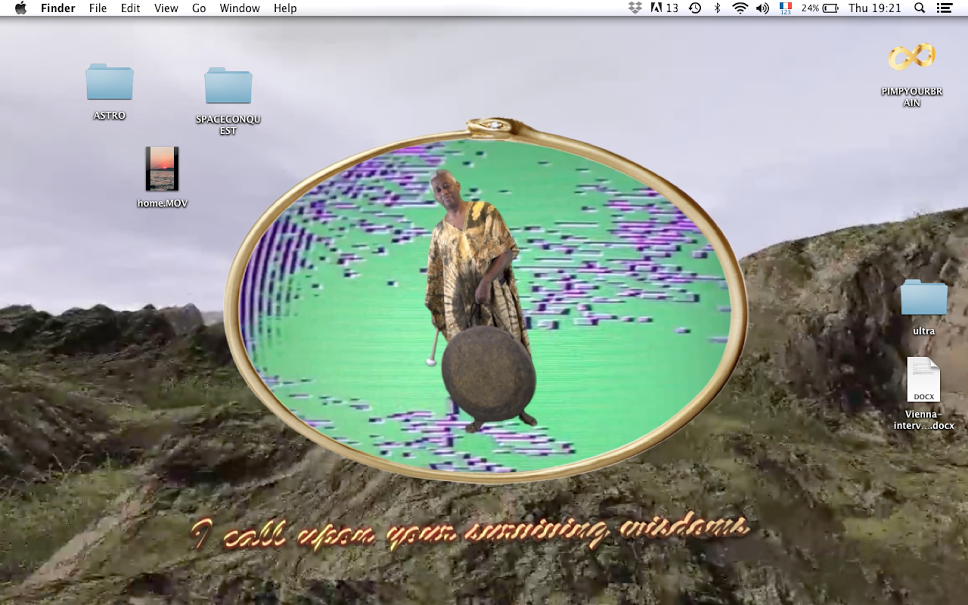
Header image: still from Sugar Walls Teardom, 2017
